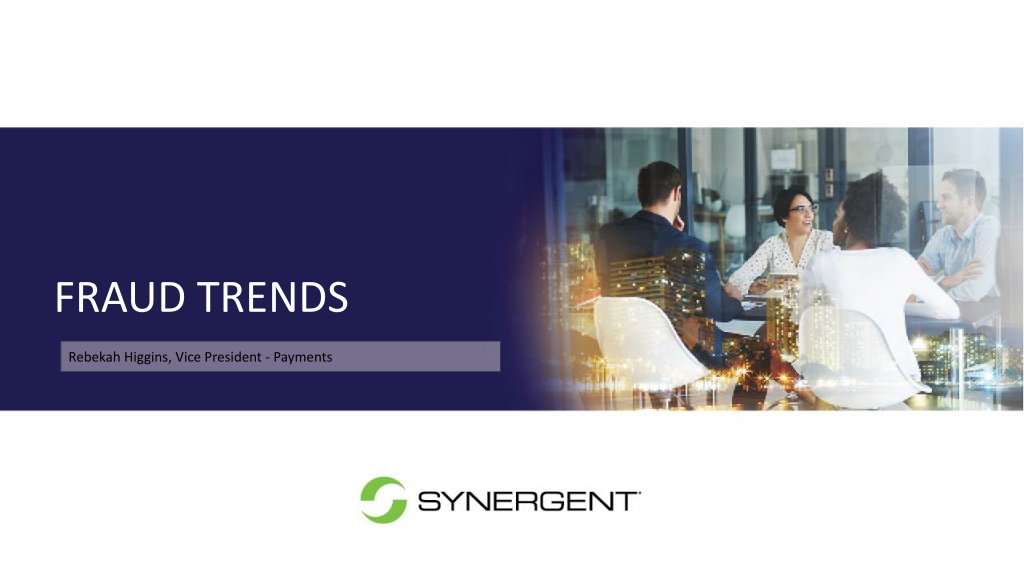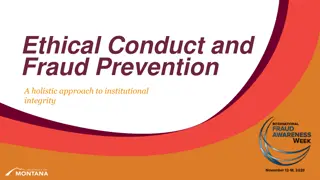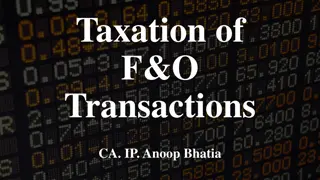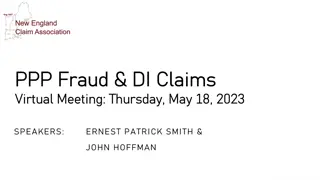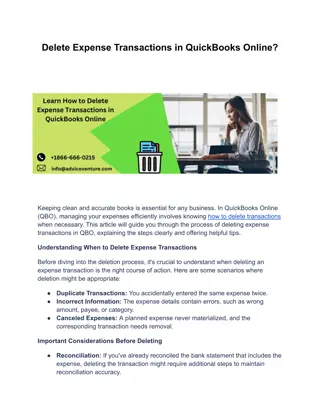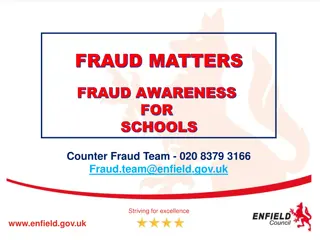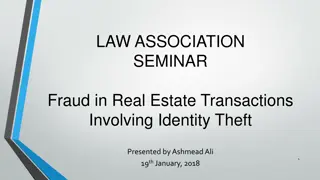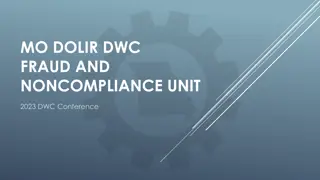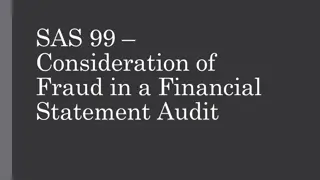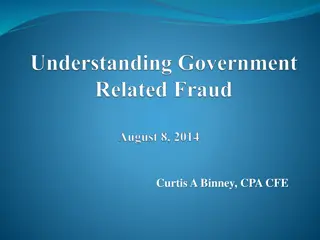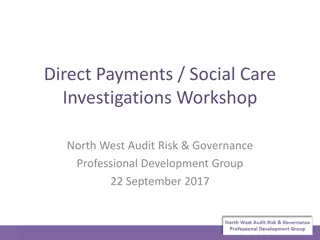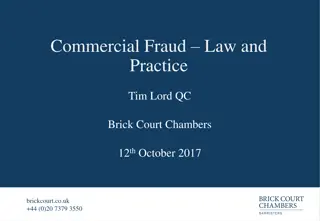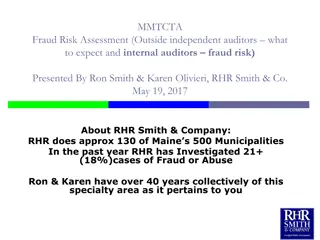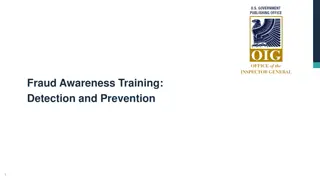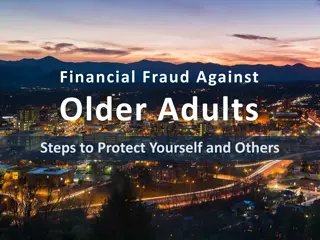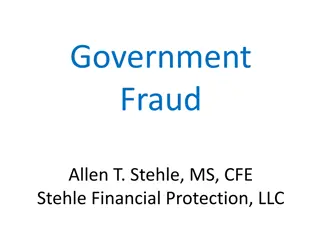Understanding the Escalating Threat of Fraud in Financial Transactions
Rebekah Higgins, Vice President of Payments, delves into the alarming rise of fraud in financial transactions, revealing staggering statistics, emerging threats, and the critical need for prevention tools. The presentation covers fraud trends, common types of fraud, transaction flow, and the key players in the payment ecosystem.
Download Presentation

Please find below an Image/Link to download the presentation.
The content on the website is provided AS IS for your information and personal use only. It may not be sold, licensed, or shared on other websites without obtaining consent from the author. Download presentation by click this link. If you encounter any issues during the download, it is possible that the publisher has removed the file from their server.
E N D
Presentation Transcript
FRAUD TRENDS Rebekah Higgins, Vice President - Payments
AGENDA Fraud stats Transaction flow Common types of fraud Prevention tools Tips and tricks Questions
New Threats Are Emerging Every Day Fraud is costly and complex than ever with no slow down in sight Before the Transaction $6 Billion Annual cost to lenders due to synthetic IDs During the Transaction $56 Billion Reported identity fraud across 49 million consumers After the Transaction 80% of financial crime schemes are driven by organized crime $6 Trillion Cybercrime damage annually $382 Million Fraud linked to COVID in the United States 4.2 Billion Records breached in the past year
FRAUD VERSUS FRICTION One in 6 U.S. consumers experiences a false decline false decline One in 6 U.S. consumers experiences a 15% of consumers will reduce their spending with one false decline spending with one false decline 15% of consumers will reduce their 20% of consumers with more than one false decline stop using that card. false decline stop using that card. 20% of consumers with more than one
WHO ARE THE PLAYERS? Processor for the Merchant/Acquirer EFT Processor for Issuer Consumer Networks Merchant/Acquirer Set the rules and standards for transaction processing Provide connectivity between merchant and issuer Settlement of funds Governance of structure - disputes Gateway for transaction processing Consolidator for card issuers Want access to funds Want to move or to get money Provides goods and/or services to consumer Facilitates transaction from merchant terminal Reviews routing tables to determine which network to route transaction Core/Host Processing System Keeper of consumer account Gateway for transaction processing
POINT OF SALE TRANSACTION Merchant Processing System Issuer Processor Core/Host Processor Network
COMMON TYPES OF FRAUD
COMMON TYPES OF FRAUD Phishing, smishing, vishing Card Fraud Identity theft Account takeover Cyber fraud Synthetic fraud
PHISHING/SMISHING/VISHING Fraudsters design scams to lure unsuspecting people into revealing sensitive information Commonly completed via fake emails, text messages, links, cloned websites, phone calls and pop-up windows that appear legitimate Motivated to gather card data to perform purchases and/or transfer money into another account Commonly linked to account take over and card fraud
CARD FRAUD BIN BRUTE FORCE ATTACKS Targets the for six-eight digits of the card number or Bank Identification Number (BIN) used to identify a card issuer Sophisticated software programs are used to randomly generate the remaining digits of a specific card number in various combinations Small, online transactions are completed to identify open/active cards Software algorithms are used to perform test runs at a high velocity with the same purchase amounts, expiration dates and CVV codes in various combinations Once successful, a card will be used at a multitude of merchants for larger dollar amounts
CARD FRAUD CARD CRACKING Consumer responds to an online solicitation for easy money by providing card information to withdraw fake check deposits Target audience is typically consumers between the ages of 19-25, college students, newly enlisted military and single parents Victims quickly become accomplices by providing card data including PIN and online credentials to provide access to their accounts Fraudster deposits worthless checks via mobile deposit and then immediately withdraws funds at an ATM Cardholder reports card stolen, receives reimbursement and fraudster shares portion of proceeds with them.
IDENTITY THEFT Occurs when someone steals personal or financial information to commit fraud or other crimes Typically goes beyond card fraud and involves personally identifiable information (PII) More difficult to identify than card fraud No liability limit Can last for an extensive period of time
ACCOUNT TAKE OVER FRAUD Occurs when someone gains access to a victim s login credentials to steal funds and information Linked to other forms of fraud Begins with the harvesting of personal information via data breaches or purchasing on the Dark Web Fraudsters change account information, password, and notifications so legitimate owner is not aware of activity on the account Ends with fraudulent and unauthorized transactions
METHODS FOR ACCOUNT TAKE OVER FRAUD Phishing Credential stuffing SIM card swapping Malware Mobile banking trojans Man-in-the-middle attacks
CYBER FRAUD Crimes committed via the internet with the intent corrupt another individual s personal and financial information stored online Popular forms of Cyber Fraud Malware Ransomware DDoS Attacks Email scams
SYNTHETIC FRAUD Real Social Security Number (SSN) is stolen, and then personal information is made up and applied to create a new identity Common victims include children, the elderly and homeless individuals due to lack of credit monitoring Manipulated Synthetics based on real identity with limited changes to SSN and other PII Manufactured Synthetics valid data from multiple identities or invalid data
After the Transaction After the Transaction Before the Transaction Before the Transaction During the Transaction During the Transaction EMV Credit union-defined, multi- channel consumer notifications BIN level transaction monitoring Step Up Authentication 100% real-time scoring 3D Secure 2.0 Behavior-based algorithms to detect fraudulent transactions Feedback loop into platform- wide consortium model Card Controls Case management tools to manage fraud Dark Web Monitoring Consulting Reporting
STEP UP AUTHENTICATION Call Types What Is Step Up? Benefits Manual Activations A unique one-time passcode sent to the cardholder Securely authenticates the cardholder Fraud case response without unique case # Uses technology the cardholder uses daily and is familiar with Digital wallet provisioning Used when contacting call centers for high-risk call types Can also be initiated by the FI
3D SECURE Zero Touch Consumer Experience Benefits Payment Risk Analytics Provides Advanced Security Increases interchange revenue Multi-component, multi-channel risk assessment Eliminates need for password, merchant enrollment, activation during shopping Decreases losses Reduced risk exposure Self-learning behavioral fraud detection model Zero interaction from cardholder provides frictionless experience Reduced abandonment rates Instant case management and reporting Frictionless online payment experience Industry-leading risk engine rules, neural network models No cardholder registration, challenge questions Spot and isolate devices with suspicious activity used in multiple transactions Real-time behavioral analytics
CARD CONTROLS Most effective when embedded into mobile and online banking and fully branded by financial institution Connected experiences across web and mobile Wide range of features to help mitigate fraud: Lock & Unlock Card Set Controls & Alerts Create a Travel Plan Click to Disable Card Receive Fraud Alerts
RULE WRITING TIPS Rules to Avoid Too targeted Too broad Aimed at stopping activity unrelated to fraud Velocity or timer rules Good Rules Address a specific type of fraud that affects a large number of cards, while showing a low, projected false positive ratio Are broad or wide-scope, only if based on actual transaction data and show a low projected false positive ratio Use a narrow-scope to stop very specific fraud events
TIPS AND TRICKS Require random or complex passwords for cardholders When in doubt call back Randomize card numbers and expiration dates Monitoring Increased denials for invalid expiration date, invalid CVV in short time periods Setting transaction limits Daily spend Velocity Staff authority Educate, educate, educate
